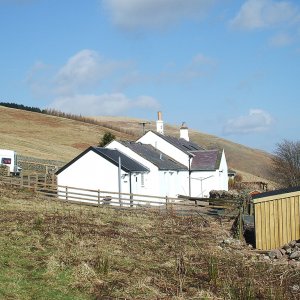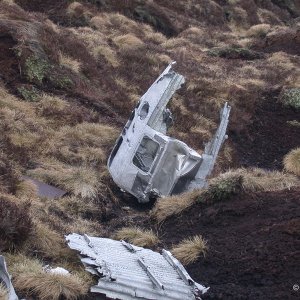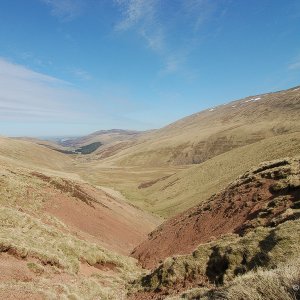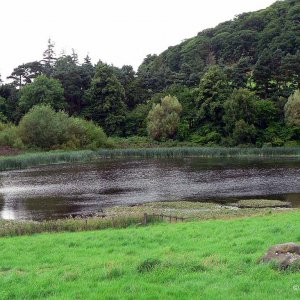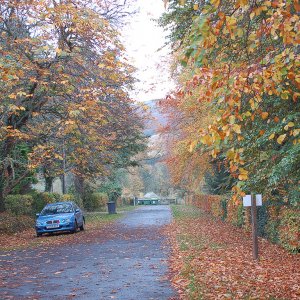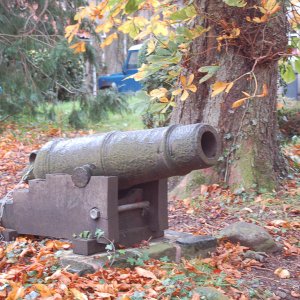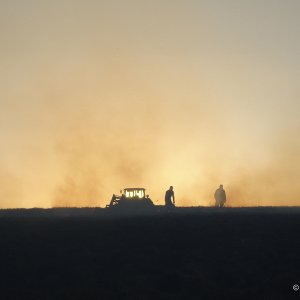A Visit to a Forgotten Wilderness in the Cheviot Hills
Right up in the north east corner of England, in the Cheviot Hills near the border with Scotland, is a hidden valley with over 12,000 acres of wilderness. You won’t find any signposts pointing the way and there is only one narrow road to access the valley, but once you are there then there is much to see and wonder at. This is the College Valley of North Northumberland.
The border between England and Scotland was fought over for nearly 300 years until the union in the early 17th century. There were large pitched battles where thousands were killed, followed by the lawless years. Out of these difficult times has come a land where development was limited and visitors can still get a sense of what the land was like across the centuries.
Let me describe the area first, then the history and finally I will take you on a tour up the valley.

College Valley, Northumberland.
The Area
The Cheviot is based around the core of a long extinct volcano. The rocks are hard and non-porous so you get acidic peat bogs and it becomes a hard life for the feral goats, otters and wildlife up here. The hills seem to catch the westerly rain clouds and every 10 years or so there are bad flash floods. The ridge walks are tremendous with views well into the Scottish borders. There is good walking here and it is no accident that three main long distance walks - Pennine Way, Ravenber Way and St Cuthberts Way -cross or run through the valley.
The History
Neolithic man was here when the area was a wild wood for many miles. There is a large stone circle along the valley bottom and then a sequence of iron age forts along the summits.
From Roman times we can trace the outline of old habitation. Back in the late 2nd century and early 3rd century AD the Emperor Severus brought his legions north into Scotland. There are marching camps outside the valley as they sought to extend their empire.
The middle ages brought new visitors to the area. Early Christianity came to Lindisfarne just to the east and along the Northumberland coast. And then just outside the entrance to the valley lies the remains of the Royal Palace at Ad Gefrin where thousands were baptised in the small river.
For those of us who like the tales of King Arthur there is a strong belief that one of his twelve battles was here alongside the River Glen.
There was a long held tradition of bringing the farm animals up onto the hills for grazing during the summer months. This is known as transhumance and the valley was a natural access point for highland pastures. It must have been an exciting time when the herds were driven south and up onto the Cheviot.
The Scottish wars of succession started in the late 14th century and from this point on there was violence across the Borderlands. Words like blackmail, bereaved and similar descriptions come down to us from these days. The valley was a natural crossing point for raiders and an old Pele tower bears witness to the lengths the locals went to protect themselves.
Any Scottish King wishing to raid into the North East of England would cross the low land to the north of the Valley and in 1513 James IV of Scotland brought his army southwards. Battle was joined on Flodden field some 10 miles or so outside the valley. If you sit on one of the hills looking north then it is plausible to believe that a shepherd up here would have heard the sounds of battle as some 10,000 men were slaughtered in one afternoon.
After the Union between England and Scotland in 1603 a relative peace came to the Border lands. There was still more poverty than usual but the land was quiet.
In the 18th and 19th centuries mining brought new found wealth to the North East. Large estates prospered and grew. This was a time of consolidation and Lord Collingwood came to inherit the lands around here. This is Lord Collingwood who took charge from Nelson at Trafalgar and also then went on to plant oak trees in the hope that they would give wood for the navy of the future. As it turned out the trees wouldn’t grow tall in these windswept hills and by then anyway we had metal hulled ships.
The estate was quiet for another 130 years. During this time social reform came to the country and some of the more prominent reformers came from near here. Then WW2 came and with it the 18 planes which crashed over and into the Cheviot Hills. The pilots and crew came from a diverse background, there were Americans, Dutch, Polish and of course English.
Google Map
View College Valley, Northhumberland, England in a larger map.
A Journey Through College Valley
We start at the small hamlet of Kirknewton and a side road which seems little more than a farm track. Note the houses with red pantiles and the undeveloped and derelict barns. Quite a change from the coast where every spare building is converted for tourism.
The small road rises and at the crest look to your right where a small plantation was planted to commemorate the Battle of Trafalgar. The oaks, so painstakingly planted by Collingwood, are on the hill to your left.
Follow the road down into the valley. The field on your left is a favourite lambing field come the spring.
Take the left turn into Hethpool. There is a lake on your left and from here a small wheel generated electricity at the start of the 20th century. The row of houses in Hethpool are well known for the arts and crafts style of building.
You are now following St Cuthberts Way. The road now heads directly south along the valley floor. Go over a cattle grid and there is a small car park on your left. Beyond this point it is private road and for a car you need a £10 permit. The field on your right is where the Neolithic stone circle lies and the small hill above, Great Hetha, has an Iron Age hill fort on the top.
The road runs for nearly two miles until you reach Cuddystone Hall. This was built in the 1960's for the valley people as a place to meet. It now caters for weddings. Just outside the Hall is the small memorial to the WW2 plane crash victims.
At this point look at the hill directly ahead. Can you see what looks like a large cairn on the top? Well this is Braydon Crags and just below an American flying fortress ploughed into the peat hags during WW2.
We will now turn left and cross the small stream and head into the Lambden valley. Like all the roads into the College Valley this is a dead end but before then you can park just below Dunsdale house and from here there are excellent walks onto the Cheviot via Bizzle crags or Braydon crags.
If we had carried straight on and past Cuddystone we would eventually have arrived at Mounthooley YHA. Here there is cheap accommodation and easy access to the back end of the Cheviot with its famous Henhole (in reality a hanging valley left from the last ice age).

Hethpool Mill, College Valley, Northumberland.
Walks in the Valley
Getting to the Valley
The nearest airports are Edinburgh and Newcastle. Both are approximately 50 miles away. The nearest train station is Berwick upon Tweed, 20 miles away.
By road, take the A697 to Wooler. Then the Kirk Yetholm road until you come to Kirk Newton. Then follow the instructions above to see the valley.
Accommodation in the Valley
The accommodation describe below can be booked through Northumbria Byways.
Hethpool House: As WW1 came to an end, Sir Arthur Munro Sutherland, purchased the estate and rebuilt Hethpool house for his "country residence". Compared to some of the larger Northumberland estates the house is small but this really doesn't matter as it has settled down to become part of the scenery. With it's small towers and austere walls there is a definite resemblance to the country houses which are much more common across the border and into Scotland. Perhaps not surprising as his family originally came from Thurso right up in the northernmost tip of Scotland.
For the last 40 years or so it has been the home of Martin and Eildon Letts. This is where they raised their family and where Martin became master of hounds for the local hunt. It is full of mementoes of a country life and you can stay here as their guests as it is a B&B which also does rather nice dinners.
Hethpool Mill: Across the College burn from the B&B lies Hethpool Mill. The National Park website says that a Mill was here back in 1212 and the house has been converted to a large open plan residence sleeping 4. As with all properties in the Valley dogs are allowed.
Coldburn Cottage: If you head south into the valley and then take the road towards the Lambden valley you will soon pass, on your right, Coldburn Cottage. This is an old farm cottage with two small bedrooms up steep stairs and a lovely enclosed garden with great views towards the Cheviot. Popular with couples it is small and cosy. During the summer months the garden has honeysuckle, cherry trees and climbing roses. There is also a small stream outside.
Dunsdale House: Higher up and just below Bizzle crags sits Dunsdale house. Possibly the highest house in Northumberland it now offers extended accommodation for family gatherings and can sleep up to 8 guests. There is also a double dog kennel outside.
More Photos
Resources
This introduction to the College Valley was written by Colin Corlett. He writes about Northumberland, local history and also loves Sci fi and audio books.
© 2014 Colin Corlett, August 2014
Right up in the north east corner of England, in the Cheviot Hills near the border with Scotland, is a hidden valley with over 12,000 acres of wilderness. You won’t find any signposts pointing the way and there is only one narrow road to access the valley, but once you are there then there is much to see and wonder at. This is the College Valley of North Northumberland.
The border between England and Scotland was fought over for nearly 300 years until the union in the early 17th century. There were large pitched battles where thousands were killed, followed by the lawless years. Out of these difficult times has come a land where development was limited and visitors can still get a sense of what the land was like across the centuries.
Let me describe the area first, then the history and finally I will take you on a tour up the valley.

College Valley, Northumberland.
The Area
The Cheviot is based around the core of a long extinct volcano. The rocks are hard and non-porous so you get acidic peat bogs and it becomes a hard life for the feral goats, otters and wildlife up here. The hills seem to catch the westerly rain clouds and every 10 years or so there are bad flash floods. The ridge walks are tremendous with views well into the Scottish borders. There is good walking here and it is no accident that three main long distance walks - Pennine Way, Ravenber Way and St Cuthberts Way -cross or run through the valley.
The History
Neolithic man was here when the area was a wild wood for many miles. There is a large stone circle along the valley bottom and then a sequence of iron age forts along the summits.
From Roman times we can trace the outline of old habitation. Back in the late 2nd century and early 3rd century AD the Emperor Severus brought his legions north into Scotland. There are marching camps outside the valley as they sought to extend their empire.
The middle ages brought new visitors to the area. Early Christianity came to Lindisfarne just to the east and along the Northumberland coast. And then just outside the entrance to the valley lies the remains of the Royal Palace at Ad Gefrin where thousands were baptised in the small river.
For those of us who like the tales of King Arthur there is a strong belief that one of his twelve battles was here alongside the River Glen.
There was a long held tradition of bringing the farm animals up onto the hills for grazing during the summer months. This is known as transhumance and the valley was a natural access point for highland pastures. It must have been an exciting time when the herds were driven south and up onto the Cheviot.
The Scottish wars of succession started in the late 14th century and from this point on there was violence across the Borderlands. Words like blackmail, bereaved and similar descriptions come down to us from these days. The valley was a natural crossing point for raiders and an old Pele tower bears witness to the lengths the locals went to protect themselves.
Any Scottish King wishing to raid into the North East of England would cross the low land to the north of the Valley and in 1513 James IV of Scotland brought his army southwards. Battle was joined on Flodden field some 10 miles or so outside the valley. If you sit on one of the hills looking north then it is plausible to believe that a shepherd up here would have heard the sounds of battle as some 10,000 men were slaughtered in one afternoon.
After the Union between England and Scotland in 1603 a relative peace came to the Border lands. There was still more poverty than usual but the land was quiet.
In the 18th and 19th centuries mining brought new found wealth to the North East. Large estates prospered and grew. This was a time of consolidation and Lord Collingwood came to inherit the lands around here. This is Lord Collingwood who took charge from Nelson at Trafalgar and also then went on to plant oak trees in the hope that they would give wood for the navy of the future. As it turned out the trees wouldn’t grow tall in these windswept hills and by then anyway we had metal hulled ships.
The estate was quiet for another 130 years. During this time social reform came to the country and some of the more prominent reformers came from near here. Then WW2 came and with it the 18 planes which crashed over and into the Cheviot Hills. The pilots and crew came from a diverse background, there were Americans, Dutch, Polish and of course English.
Google Map
View College Valley, Northhumberland, England in a larger map.
A Journey Through College Valley
We start at the small hamlet of Kirknewton and a side road which seems little more than a farm track. Note the houses with red pantiles and the undeveloped and derelict barns. Quite a change from the coast where every spare building is converted for tourism.
The small road rises and at the crest look to your right where a small plantation was planted to commemorate the Battle of Trafalgar. The oaks, so painstakingly planted by Collingwood, are on the hill to your left.
Follow the road down into the valley. The field on your left is a favourite lambing field come the spring.
Take the left turn into Hethpool. There is a lake on your left and from here a small wheel generated electricity at the start of the 20th century. The row of houses in Hethpool are well known for the arts and crafts style of building.
You are now following St Cuthberts Way. The road now heads directly south along the valley floor. Go over a cattle grid and there is a small car park on your left. Beyond this point it is private road and for a car you need a £10 permit. The field on your right is where the Neolithic stone circle lies and the small hill above, Great Hetha, has an Iron Age hill fort on the top.
The road runs for nearly two miles until you reach Cuddystone Hall. This was built in the 1960's for the valley people as a place to meet. It now caters for weddings. Just outside the Hall is the small memorial to the WW2 plane crash victims.
At this point look at the hill directly ahead. Can you see what looks like a large cairn on the top? Well this is Braydon Crags and just below an American flying fortress ploughed into the peat hags during WW2.
We will now turn left and cross the small stream and head into the Lambden valley. Like all the roads into the College Valley this is a dead end but before then you can park just below Dunsdale house and from here there are excellent walks onto the Cheviot via Bizzle crags or Braydon crags.
If we had carried straight on and past Cuddystone we would eventually have arrived at Mounthooley YHA. Here there is cheap accommodation and easy access to the back end of the Cheviot with its famous Henhole (in reality a hanging valley left from the last ice age).

Hethpool Mill, College Valley, Northumberland.
Walks in the Valley
- From the car park onto Great Hetha. Explore the remains of the Iron Age fort and then drop down into the Elsdonburn valley on the other side. Follow the road back. Maybe 2 to 3 hours.
- From the car park and along the eastern rim. Look out for the feral goats. Follow the Newton Tors with great views onto the Cheviot and then back along the valley floor. At least 4 hours.
- The Schil walk from Mounthooley. 3 hours traversing the Pennine Way section in reverse. Great views and see into the Henhole.
- Dunsdale to Braydon Crags. Up to 3 hours. Explore the hidden valleys up here and see if you can the remains of the flying fortress amongst the peat hags.
Getting to the Valley
The nearest airports are Edinburgh and Newcastle. Both are approximately 50 miles away. The nearest train station is Berwick upon Tweed, 20 miles away.
By road, take the A697 to Wooler. Then the Kirk Yetholm road until you come to Kirk Newton. Then follow the instructions above to see the valley.
Accommodation in the Valley
The accommodation describe below can be booked through Northumbria Byways.
Hethpool House: As WW1 came to an end, Sir Arthur Munro Sutherland, purchased the estate and rebuilt Hethpool house for his "country residence". Compared to some of the larger Northumberland estates the house is small but this really doesn't matter as it has settled down to become part of the scenery. With it's small towers and austere walls there is a definite resemblance to the country houses which are much more common across the border and into Scotland. Perhaps not surprising as his family originally came from Thurso right up in the northernmost tip of Scotland.
For the last 40 years or so it has been the home of Martin and Eildon Letts. This is where they raised their family and where Martin became master of hounds for the local hunt. It is full of mementoes of a country life and you can stay here as their guests as it is a B&B which also does rather nice dinners.
Hethpool Mill: Across the College burn from the B&B lies Hethpool Mill. The National Park website says that a Mill was here back in 1212 and the house has been converted to a large open plan residence sleeping 4. As with all properties in the Valley dogs are allowed.
Coldburn Cottage: If you head south into the valley and then take the road towards the Lambden valley you will soon pass, on your right, Coldburn Cottage. This is an old farm cottage with two small bedrooms up steep stairs and a lovely enclosed garden with great views towards the Cheviot. Popular with couples it is small and cosy. During the summer months the garden has honeysuckle, cherry trees and climbing roses. There is also a small stream outside.
Dunsdale House: Higher up and just below Bizzle crags sits Dunsdale house. Possibly the highest house in Northumberland it now offers extended accommodation for family gatherings and can sleep up to 8 guests. There is also a double dog kennel outside.
More Photos
Northumberland, The College Valley
- Pauline
- 14
A Visit to a Forgotten Wilderness in the Cheviot Hills.
Resources
- College Valley Website - Estate details and background. A good history page as well.
- Northumbria Byways - Vacation rentals (self catering) in the Valley. Introduction to the holiday cottages and a good google map of the Valley.
- Hethpool Mill Blog - This blog has lots of interesting pictures and gives a more detailed introduction to the beauty of the Valley.
- Hethpool House - Sir Arthur Munro Sutherland’s old country house. You can stay here as Eildon and Martin Letts offer B&B and a rather good dinner as well.
This introduction to the College Valley was written by Colin Corlett. He writes about Northumberland, local history and also loves Sci fi and audio books.
© 2014 Colin Corlett, August 2014

